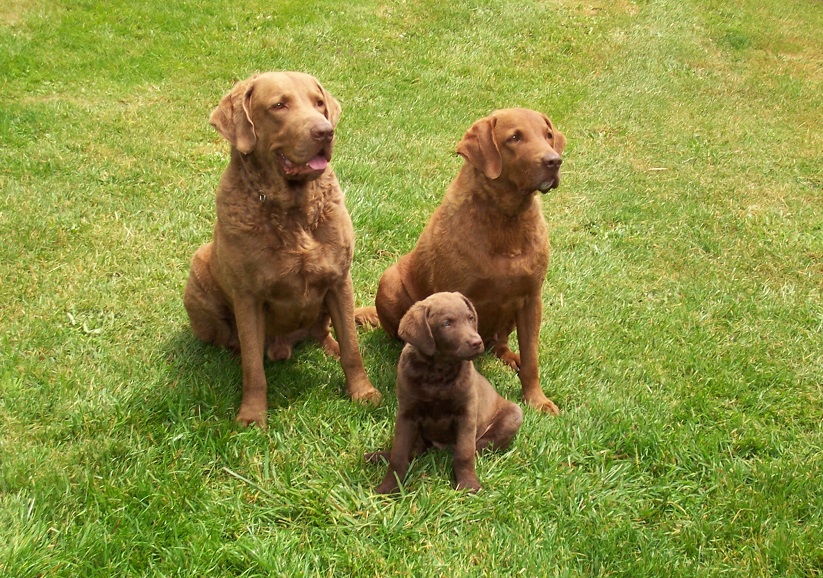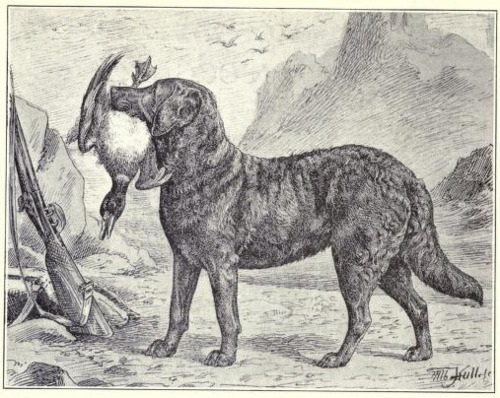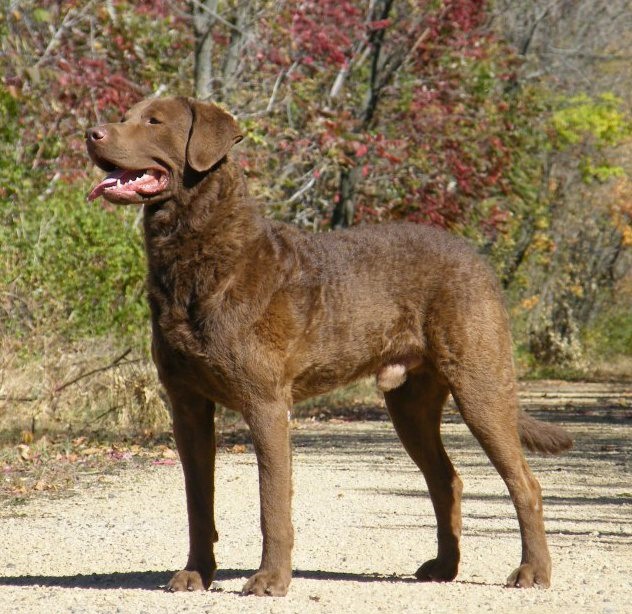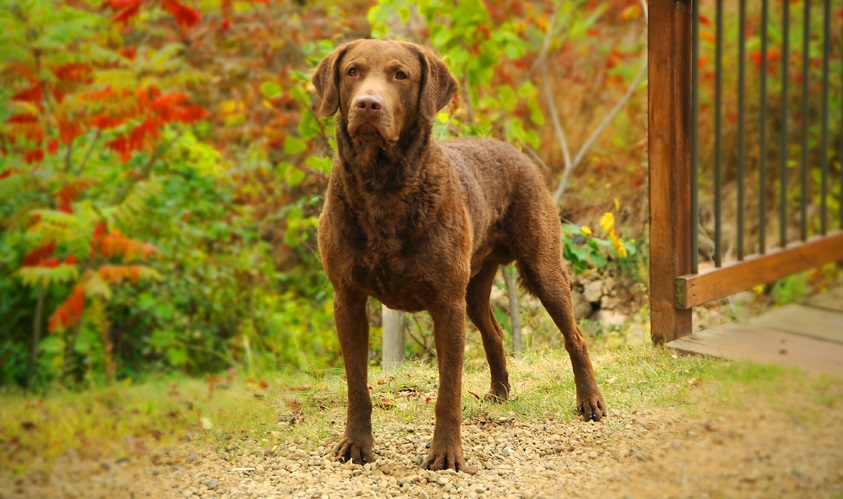The Chesapeake Bay Retriever is a powerful, muscular dog. This dog used in the harsh climatic conditions of the Chesapeake Bay in Maryland The breed Chesapeake Bay Retriever, also known as Chessy, descended from what is believed to be from two puppies of newfoundlands who survived a shipwreck in the Bay Area in 1807. These puppies used to breed local dogs. As a result, a dog with thick brown hair, with good stamina and developed intelligence.
Chesapeake people love water and become strong, powerful swimmers, using your tail as a helm. They are great for work in cold water, which may be ice crust. Chessy have a short coarse coat, impervious to water.
These dogs can do all kinds of jobs, but first, for that many owners value them – they are excellent hunting instincts and characteristics. They have an excellent sense of smell, and in addition to their stubbornness, they are able to find fallen prey in the most hard to reach places. There are many stories according to with whom the Bay Retriever found and delivered to the hunter at least 100 ducks for day.

Chesapeake is friendly, outgoing and obedient, although they may be “canny”. With their strength and intelligence, they can easily overcome not not only an untrained owner, but even an experienced dog lover. They need strict discipline, then they will be ready to become hardworking and obedient companions. Daily long walking or swimming will guarantee that the dog will be quiet enough in the house.
Chessies are often best friends for children, however they are not will endure violence on their part. In most cases, if he I don’t like the situation, he’ll just get up and leave, if it’s perhaps. Any interaction between young children and a dog must always be supervised.
Breed history
Contents
The Chesapeake Bay Retriever is one of the few breeds that occurred in the USA. The breed is believed to have descended from two dogs Newfoundlands who sailed on a ship bound for England in 1807 This ship ran aground, and the entire crew, including dogs, were saved. Then one of the sailors found a new home for the dogs, in which they grew up.

Both dogs have gained a reputation as excellent swimmers, especially when it came down to duck hunting. Their puppies inherited their unusual characteristic – unusual yellowish or amber eyes. The breed was recognized in Baltimore in 1877 and first received name Chesapeake Bay Duck Dog.
A little later, in 1884, the American Club was created dog breeding. By then, it was developed for the Chesapeake. standard, and the breed itself has become well known for its endurance and the ability to work in icy waters. First Chesapeake Bay Club Retriever was created in 1918 in the USA. It is significant that front door at the Chesapeake Bay Maritime Museum in St. Michael, Maryland, guarded by a pair of cast-iron statues of Chesapeake Bay retriever.
Dimensions
The growth of males and females is 58-66 cm and 53-61 cm respectively. The weight of the Chesapeake dogs is from 29 to 36 kg, bitches – from 25 to 32 kg.
Character Chesapeake Bay Retriever
Real Chesapeake have a bright and cheerful character that combined with courage, intelligence and vigilance, which makes them excellent guard dogs. They can also be “on your mind”, therefore need solid and consistent socialization and preparation for adulthood. Don’t let him do something “only once”, either you will spend on repetition or retraining for several days or weeks. To put the Chesapeake instead of a sharp look or an oral remark, more severe punishment will be overkill and will only worsen it mood and complicate learning.

Chesapeake dogs are generally smart and obedient dogs, they lend themselves to training and can please you with results, despite the fact that they learn a little slowly. These dogs are friendly and good. get along with the kids. Dogs of this breed have a real passion for water and love swimming. Chesapeake will also get along with cats, who already live in your house, but they can run after others cats. Chesapeake Bay Retrievers not recommended for inexperienced dog owners.
The owner must be sure that he has a natural power over the dog. If possible a course should be attended with this breed. obedience training. Chesapeake can be quite dominant character, so they can develop various problems dominance if they feel that their owners are passive or timid.

Chesapeake Bay Retriever is crucial to ensure the right socialization. Introduce your puppy to as many others as possible dogs. Typically, the Chesapeake is more influential than other retrievers. Without proper leadership, they may become too dominant, aggressive, and will not be able to get along with other dogs. Chessy have powerful fangs and jaws that also require proper preparation and management.
Diseases and Health
Chesapeake retrievers have a life expectancy of 10 to 12 years, they usually have good health, but like many breeds, they prone to certain diseases and disorders. They are characteristic following disorders:
- Hip Dysplasia
- Expansion of the stomach and inversion of the intestines
- Progressive Retinal Atrophy
- Bouts of epilepsy
Maintenance and care
Chesapeake Bay Retrievers love the cold climate. When it’s hot they do your best to swim. Chesapeake need long exercises to help them relax and make them quiet at home while you watch TV. It will be enough for them an hour of active walk per day, or half an hour of intense exercises and water games. Chessy love to swim and do it extremely good. Chesapeake can also be described as dogs for the suburbs, but not for the city.
Chesapeake puppies need special exercises. Beginning with age at 9 weeks and up to 4 months, puppies should once or twice undergo training and socialization per week, as well as continuous playing for 15-20 minutes with the ball or splashing around in the pool. C 4 and up to 6 months old puppies must be obediently trained daily. During this time, you should gradually increase the passable distance for a walk, which by 6 months should be at least 1 km

Chesapeake people work well with people, but they tend to be independent, or even independent. In training use positive reinforcement methods such as praise and goodies in as a reward. In the case of tough chessi methods can become more persistent and less willing to undergo training. Best way to educate Chesapeake something new is to make learning interesting and make him feel like he has a choice.
When the Chesapeake does something inappropriate, for example, marks in the house, you must immediately make it clear to him, and loudly and firmly tell him – this behavior is unacceptable and should never be repeated!
Key Features
- Chesapeake Bay Retrievers require a large number of physical exercises, including swimming, if possible.
- The breed is prone to problems of dominance, so the dog must be properly trained and socialized.
- Chesapeake have a specific smell of wool.
- Chesapeake is not suitable for inexperienced or novice owners dogs.
- These dogs can be aggressive towards others. to dogs
- Chesapeake Bay Retrievers are more aggressive and alert to to strangers than other retrievers.
- Chesapeake – strong dogs that mature enough slow and prone to territorial aggression, therefore, may be excellent guard dogs.
The cost of puppies
The price of Chesapeake Bay Retriever puppies is around $ 500. AT The breed practically does not occur in Russia and the CIS, therefore There are no domestic professional breeders yet.






